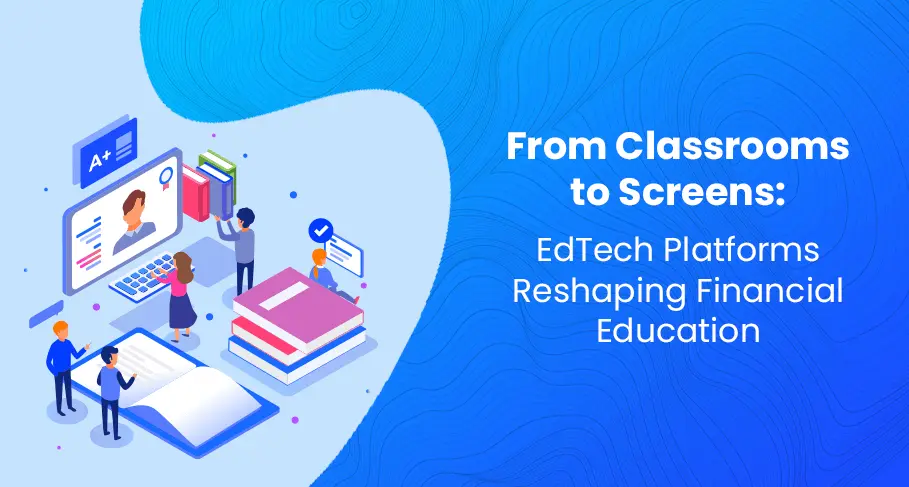Technological advancements since the early 2000s, particularly the development and widespread adoption of the Internet, have revolutionised how people consume information. The World Wide Web has become a vast repository of knowledge, and the rise of mobile devices has enabled people to access and retrieve information from almost anywhere in the world at any time.
This change has also greatly affected the education sector, leading to a significant shift away from traditional sources of information such as books and towards online platforms and digital libraries. Educational recourses on any number of topics and with many personalisation options have become easily available. The EdTech market was valued at $129 billion in 2022 and is expected to reach $42 billion by 2032.
While EdTech isn’t without its imperfections and can’t be seen as a universal solution to all educational challenges, it undeniably plays a pivotal role in advancing various sectors, including finance. Its most significant impact on the financial industry lies in its ability to democratise financial education, making it more accessible to a wider audience. And here is how it does so.
How the Rise of EdTech Affected Approaches to Financial Education
Back in the 2000s, the finance world resembled the “Stone Age” with no smartphones, podcasts that could be listened to on the go, or any other novelties of a similar nature. The only kind of information that could be found was either in printed books or on various websites, with an occasional video tutorial here and there, depending on the topic.
Other forms of educational content gradually developed from there, but the transition to e-learning was admittedly a slow and uneven process. There were very few experts in the field of financial education who could reliably make a shift towards online teaching methods without losing out on the quality of education offered.
These days, most people practically live on the Web, in light of which user-focused businesses and market experts are also increasingly learning to move their training online. As a result, a great variety of new content formats came into existence – you can now find videos on financial advice, even on social platforms like TikTok.
Utilising such platforms enabled content creators and teachers to share their expertise in a very convenient manner, while potential learners can get access to quality education without having to pay exorbitant costs.
Financial Literacy: Before and After EdTech
Bringing EdTech tools into the proverbial classroom has certainly made education more inclusive, personalised, and possibly more engaging for many participants. But what kind of results does it have to show for this change?
The lack of financial literacy remains a prevalent problem in today’s world. A survey conducted by the United States National Financial Educators Council showed that just in 2022, a considerable portion of the country’s residents suffered losses due to their lack of education on the subject. 15% of the survey’s respondents lost over $10,000 because of this issue.
Global data seems to indicate that only 33% of adults worldwide have a solid grasp of at least basic financial concepts, which leaves billions of people lacking in this regard. So, it appears that despite the broadening availability of learning methods due to EdTech, the fundamental problem has yet to be fixed.
But should this be considered the failing of the educational tools themselves, or does the matter go deeper? Considering some of my previous experiences, I have to wonder.
Opportunity to Learn Makes or Breaks any Education System
Back in 2009, I spearheaded the development of an e-learning platform that used webinars as its primary method of education. My platform conducted about 200 webinars per month. Companies and private traders alike would buy lesson packs and undergo their training. And the one thing I observed is that the majority of people who paid for their lessons never completed their study courses.
That honestly left me stumped for a while, as I could not understand the reasoning for such behaviour. The years went on, and I continued to observe similar attitudes on other educational platforms. People would subscribe to monthly lesson plans and download a package with 4-5 pieces of study materials but then never actually use them.
I had to conclude that the ultimate reason for this is that the subject of finance is still perceived as very unattainable to people. Financial topics are complex and diverse, and strong motivation is needed to engage in additional education in this area. Staying updated in this field requires continuous learning due to the evolving nature of financial markets, regulations, and investment strategies.
Another thing to mention is that people’s thinking and information consumption patterns have also changed as the attention span of adults shrinks throughout the past decades. These days, short texts and videos that take a maximum of 5-10 minutes for the mind to process are becoming the standard of content production. It tends to reflect on the learning patterns as well – many people simply don’t have the time or patience to sit still long enough to do in-depth studying, especially if you’re an adult involved in a full-time job and other responsibilities.
So Should We Just Give Up Then?
No, not at all. Even if some people may treat their education like gym memberships that never get used, it doesn’t change the fact that financial literacy is necessary. Particularly so in today’s fast-paced digital era, when navigating the complicated world of personal money is more important than ever.
If out of the total number of people who sign up for lessons, at least 10% actually study and retain what they’ve learned, then it’s already a decent result. EdTech tools have made access to knowledge a lot easier, and for people who genuinely wish to learn, the value of such availability is hard to understate.
EdTech platforms have emerged as potent solutions to empower people and should be allowed to continue doing so.
